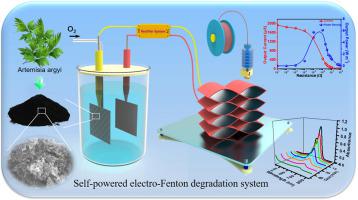Nano Energy ( IF 16.8 ) Pub Date : 2021-01-08 , DOI: 10.1016/j.nanoen.2020.105720 Yingzheng Zhu , Chen Chen , Miao Tian , Ye Chen , Yingjie Yang , Shuyan Gao

|
From the perspective of sustainability, self-powered electro-Fenton (EF) degradation is a promising trend for accelerating the large-scale application in wastewater treatment. In this work, the method of both energy supply source and preparation of high-quality EF catalysts with excellent catalytic activity is herein explored to upgrade and optimize the EF degradation system. A printed flexible wave-like triboelectric nanogenerator (PFW-TENG) is innovatively fabricated by 3D printing technology to drive EF system for methylene blue (MB) degradation catalyzed by oxygen-containing functional groups-rich N-doped porous carbon materials using artemisia argyi and MgO-ZnCl2 as carbon precursor and dual porogens respectively. The maximum instantaneous open-circuit voltage (Voc) and short circuit current (Isc) of the PFW-TENG can reach 610 V and 1.93 mA, and maximum power density can reach 6.1 W m−2 when the connected load is 1 MΩ. Such high output characteristics undoubtedly provide a strong power supply for the EF reaction. The synthesized optimal oxygen-containing functional groups-rich N-doped porous carbon materials have high N content (4.0 at.%) and large surface area (1302 m2 g−1), and the MB decolorization efficiency is surprisingly up to 98.1% within 58 min in the self-powered EF system driven by PFW-TENG. Moreover, it is found that the content of C–O–C and COOH in the carbon material is positively correlated with the decomposition efficiency. This work innovatively realizes the deep integration of cathode EF technology, oxygen-containing functional groups-rich N-doped porous carbon materials preparation technology, and digital 3D printing technology to electrochemical catalytic degrade organic pollutants, which provides innovative ideas for the large-scale application of self-powered EF systems.
中文翻译:

使用3D打印柔性摩擦纳米发电机驱动的含氧官能团丰富的生物质衍生碳催化剂的自供电式Fenton降解系统
从可持续性的角度来看,自供电的电子芬顿(EF)降解是加速大规模应用于废水处理的一种有希望的趋势。在这项工作中,本文探索了能量来源和制备具有优异催化活性的高质量EF催化剂的方法,以升级和优化EF降解系统。通过3D打印技术创新地制造了一种印刷的柔性波浪状摩擦电纳米发生器(PFW-TENG),以驱动EF系统降解亚甲基蓝(MB)。 MgO-ZnCl 2作为碳前体和双重致孔剂。最大瞬时开路电压(V oc)和PFW-TENG的短路电流(I sc)可以达到610 V和1.93 mA,并且当连接的负载为1MΩ时,最大功率密度可以达到6.1 W m -2。如此高的输出特性无疑为EF反应提供了强大的电源。合成的最优的富含富氧官能团的N掺杂多孔碳材料具有高的N含量(4.0 at。%)和大的表面积(1302 m 2 g -1)),而在由PFW-TENG驱动的自供电EF系统中,在58分钟内,MB的脱色效率令人惊讶地高达98.1%。此外,发现碳材料中的C–OC–CO和COOH的含量与分解效率呈正相关。这项工作创新地实现了阴极EF技术,富氧官能团的N掺杂多孔碳材料制备技术和数字3D打印技术在电化学催化降解有机污染物方面的深度集成,为大规模应用提供了创新的思路。自供电的EF系统。











































 京公网安备 11010802027423号
京公网安备 11010802027423号